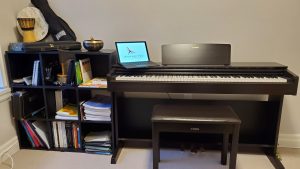Online music therapy is the offering of standard music therapy sessions through a secure video-conferencing software link. In our case, we will be using the Jane App, a software package designed to ensure compliance with healthcare privacy laws. Online music therapy has been developed as the covid-19 pandemic has forced many practitioners to stop seeing clients in-person for an extended period. This virtual option allows therapeutic relationships to continue to develop despite the need for physical distancing.
About Online Music Therapy
What is Online Music Therapy?
How does it work?
Online music therapy sessions will include many of the same activities that you could expect from in-person sessions. We may listen to music, discuss music, create music, write music, move to music, and much more! Online sessions even offer opportunities for extra creativity as we will need to find or create instruments from household objects!
The therapy space


It would be ideal if the therapy space in your home was a quiet, private room, where your child will not be interrupted or distracted by the goings on in the rest of the house. We also want to avoid restricting the volume in music therapy as big feelings may need to be expressed with big sounds, so make sure that the therapy space will also not be disruptive to other members of the household.
You will need a computer, tablet, or smartphone that can be set up in such a way that the whole room is visible.
Suggested musical items
- Wooden spoons or chopsticks for rhythm sticks
- Pots and pans for drums
- Plastic eggs or other small containers filled with dry rice for shakers
- Beads in aluminum pie tins for ocean drums
- Anything else you can think of that your child might enjoy using to make sounds
Of course pianos, guitars, ukuleles and other musical instruments are wonderful additions to music therapy, but you are by no means expected to have one or to purchase one.
Risks and benefits of online music therapy
Risks
- Despite all reasonable efforts to protect the privacy and security of electronic communication, it is not possible to guarantee the security of information exchange.
- Technology is subject to disruptions beyond our control that could prevent sessions from taking place.
- Many videoconferencing platforms do not allow for both parties to be speaking/making music at the same time.
- Children may find it difficult to engage with a therapist over videoconferencing. Some children are too young to understand the concept of real time communication over video.
Benefits
- Therapy can continue despite requirements for physicaldistancing.
- Children who feel anxiety in new settings can have therapy in the comfort of their own home.
- Parents can choose to be a part of the sessions for some, none, or all of the child’s session depending on the child’s needs.
